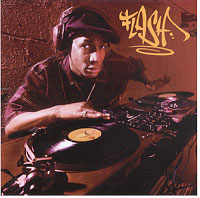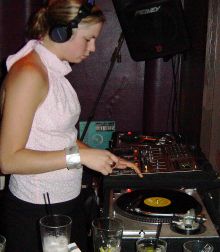DJing Basics
Disc jockey
A disc jockey (often DJ) is an individual who selects and plays pre-recorded music for the enjoyment of others. In circles and cultures where reggae and related musical styles are prevalent such as Jamaica, Panama, and other parts of the Caribbean and Latin America, the work of the "Deejay" is divided up and can also refer to an MC or rapper. The word "selector" is used as the title of the person who chooses the records, the disc jockey playing them. Thus what Jamaicans call deejaying, chatting, or toasting may be called rapping in other parts of the world. Reggae artists who sing in styles similar to rap have also been called deejays.
DJs can be heard on the radio and at any number of social gatherings, such as weddings, nightclubs, art openings, warehouse parties, and high school dances. As a result there are many different types of DJ, each fitting into a particular niche defined by performance setting (broadcast booth or nightclub) and intended audience (jazz or hip hop fans). A DJ's performance style and the techniques he or she employs must reflect these considerations. For instance, wedding DJs play music but are often expected to act as a masters of ceremony who introduce the bride and groom, lead dances, or invite guests to play games. A DJ at a rave would instead be expected to introduce a greater technical element to their performance by manipulating the songs they play in order to maintain a given tempo and energy level.
The DJ as an artist...
A phenomenon in the music community (but primarily within the sphere of popular music) is DJs who do not simply "play records," but in fact create new music through the playback and mixing of pre-recorded media. These techniques began and were developed in Jamaica in the 1960s by such influential DJs as Count Matchukie, King Stitts and U-Roy working with some of the most innovative sound recording engineers of the century including Clement "Sir Coxsone" Dodd, King Tubby, and the legendary Lee "Scratch" Perry. Phrasing, sampling, scratching, the application of effects (e.g., delay, flanging, etc.), and most importantly, toasting or rapping over music, develop an aural montage that may be spontaneous/improvised or carefully crafted. This movement is dubbed turntablism and is parallelled in surrealism and the visual arts.
However, simply "playing records" allows a DJ to bring his or her own creative ideas to bear upon pre-recorded music, much like a mix tape. Playing songs in sequence offers the opportunity to observe relationships forming between different songs. Given careful attention and control, the DJ can create these relations and encourage them to become more expressive, beautiful and telling. If successful, these relationships encourage the listener or audience towards a deeper and more complete experience of the music as well as insight into the person choosing the music sequence. This is called the art of "programming," or track selection. It can require technical skill and/or knowledge of music.
From the mid-1980s through the late-1990s, some dance-oriented genres of electronic music, especially house and techno, evolved to cater to DJs who were looking for recordings that could be more easily combined with each other in creative ways. Since DJs produce much of the music in these styles, the arrangements became more DJ-friendly — less song-oriented, tonal and melodic, and more rhythmic and repetitive, or "tracky," — thus allowing the DJ to create a hypnotic collage of music using lengthier and more complex segues between songs. This phenomenon occurred in hip hop music as well, but to a lesser extent, due to that genre's focus on lyrical structures. However, in hip hop moreso than in other genres, "DJ tool" records consisting of nothing but looping break beats and other samples, rather than complete songs, are specially produced for the benefit of DJs looking to assemble new combinations of beats and phrases "live in the mix".
Two turntables and a microphone comprise DJs' most basic equipment, although recently, new advances in digital media have enabled DJs to use computers, and CD players, with specialized software in much the same manner as with turntables. Turntables (aka. phonographs) and a microphone are connected to a mixer. DJs use a mixer's crossfader to fade between two songs playing in the turntables. Fading often includes beatmatching. Live hip hop music also often has MCs rapping to the microphone. In nightclubs the microphone is usually used only for announcements.
The Mobile DJ...
Mobile DJs provide DJ services at weddings, schools, corporate events, bar/bat mitzvahs, and other private parties. They generally bring their equipment to the place of the event. Recent developments in technology has enabled mobile DJs to easily carry more than it was possible before.
CD players with DJ-oriented features such as simulated dragging and scratching have been available for some time, and software DJ equipment such as the Native Instruments Traktor and the Hercules DJ Console enables DJs to carry hundreds of digital records on a USB hard disk and to perform as they did on typical equipment. However, vinyl-based equipment is still preferred and is widely believed to give DJs more direct control over the sound of the music. Whatever the case, as the art of the DJ has become more and more widespread, equipment has become drastically easier to find, and it is possible to find mass-market mixing equipment at outlets such as RadioShack and complete DJing kits for beginners at music stores.

